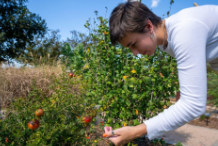Put in the work now for a productive garden next year. Before removing plants, make a sketch of the vegetable layout. This will come in handy when you’re planning the layout for the next garden if you choose to rotate your crops.
Remove debris from plants that are done producing. Compost debris that is disease-free. For smaller gardens, manually remove weeds. Larger gardens may require tilling. If so, avoid tilling while the soil is saturated as this breaks down the structure.
A cover crop can be planted to return nutrients to the soil during this off season. Cover crops also reduce soil erosion and improve the quality of the soil. Small grains such as wheat should be seeded at 3/4 to 1 pound of seed per 1,000 square feet from mid-September to late October. Spring oats can also be seeded until mid-September but the rate should be 2 to 4 pounds per 1,000 square feet. Spring oats will die back in the winter and can be tilled under in the spring. Daikon radishes are another good cover crop because the large taproot penetrates the hardpan. After the radishes die back in the winter, the loosened soil is better able to retain water.
Hairy vetch, alfalfa and sweetclover are legumes which means they also fix nitrogen. Seed these cover crops at a rate of ¼ to ½ pound of seed per 1,000 square feet of garden. Hairy vetch and alfalfa can be seeded from mid-August to late September while sweetclover should be seeded only until early-September.
Cynthia Domenghini, Extention Agent




